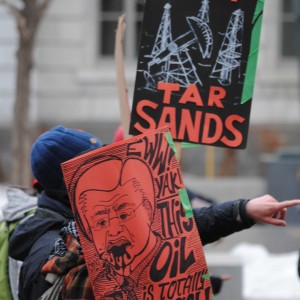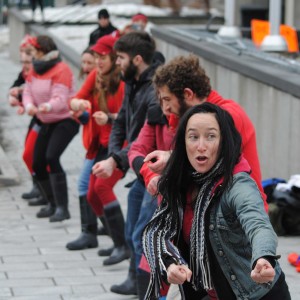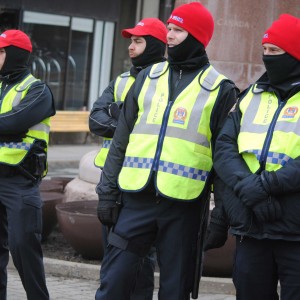It was an inspiring day, full of smiles, families, pets and a united message for government leaders: act now on climate change.
Police reports confirmed more than 25,000 Canadians from all walks of life took to the streets of Quebec City on Saturday afternoon to protest the Energy East pipeline and urge more investment in renewable energy. Most of those who attended wore red coats, shirts and hats — including red-capped police officers — to symbolize the rising temperature in a thermometer, an image that was captured from aerial shots of a roundabout in front of Quebec’s legislative assembly.
The march, the largest climate-themed protest in Canadian history, came three days before Canada’s premiers meet in Quebec’s capital for a climate summit. On Monday, Ontario Premier Kathleen Wynne is expected to sign an agreement with Quebec on a cap-and-trade system that would put a price on carbon emissions that exceed government-set limits.
Greenpeace Canada, Nature Québec, Environmental Defence and other organizers of the Act On Climate march want provincial leaders to reject the Energy East pipeline project, arguing that efforts to expand the output of the oil sands are incompatible with the actions needed to reduce greenhouse-gas emissions and keep climate change in check.
Smaller marches also took place Saturday across the country. Joanna Kerr, executive director of Greenpeace Canada, said Canadians are making it clear that they want action on climate change. “Our provincial leaders must do what’s essential by supporting renewable energy and not tar sands pipelines,” she said.
At the heart of the discussion is a contradiction in policy that few political leaders in Canada have been courageous enough to publicly acknowledge: the simultaneous push for growth in Canada’s oil patch and for a reduction in the country’s emissions. Environmental leaders say both can’t happen at the same time — something has to give.
As Alan Rusbridger, the soon-to-depart editor of the Guardian newspaper, wrote last month: “There are trillions of dollars worth of fossil fuels currently underground which, for our safety, simply cannot be extracted and burned. All else is up for debate: that much is not.”
It’s a reality that Quebecer Anne Avril, marching with her chihuahua Nina stuffed inside her coat, hopes will begin to sink in for other Canadians. “I’m here in support of renewable energy,” she said, adding that it was “inspiring” to see so many people arrive from across Canada for the march. Is public momentum behind that message building? “I hope so,” she said. “We need to send that message to the government.”
The crowd was energized and reflected Canada’s full geographic, ethnic, and demographic diversity. An estimated 100 buses arrived in the city from as far away as Northern B.C., Edmonton, Toronto and Fredericton.
“Whoa!” tweeted U.S. environmentalist and 350.org founder Bill McKibben after seeing photos from the event. “Canada is fully awake, I think.”
Whoa! seeing pics of a huge climate march in Quebec! #ActOnClimate @defendourclimate Canada is fully awake, I think (thanks Mr. Harper!)
— Bill McKibben (@billmckibben) April 11, 2015
Families walked hand-in-hand with toddlers sitting on shoulders. Many walked their dogs along the route, or pushed a family member in a wheelchair. Aboriginal children walked with elders as they beat on drums. Students chanted in unity. Musicians played their instruments, and some people dressed up as clowns. It was chilly and grey, but there were smiles all around — even for one woman who walked the 2.5 kilometre route in high heels.
“I guess we’re all environmental radicals,” said one student walking within the sea of red.
(Photos: Tyler Hamilton; thermometer shot courtesy of Act on Climate)




















